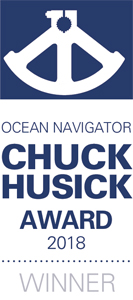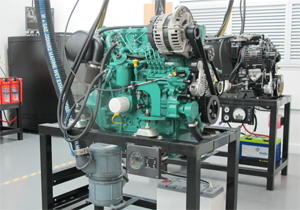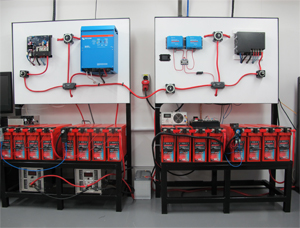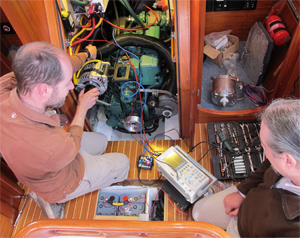 |
Editor’s note: Nigel Calder was a paid consultant on the Integrel System development project described below and has a small ownership stake in the Triskel Marine company.
Years ago when I was researching and writing the first edition of my book, Boatowner’s Mechanical and Electrical Manual, I spent a great deal of time studying ways to make electrical systems more powerful and reliable.
I also became involved with the American Boat and Yacht Council’s (ABYC) “Electrical Project Technical Committee.” This group writes the principal standards governing electrical systems on recreational boats. Over the decades, I have learned more from participating in this body than from any other source of information. I rebuilt the electrical system on my boat Nada to be more effective, and extensively rewrote the electrical sections of Boatowner’s Mechanical and Electrical Manual.
Batteries, as they had always been, were the weak link in the system, needing to be regularly fully charged but only accepting very low charge rates in the final stages of charging and, as such, necessitating frustratingly long hours — over the years, thousands of hours — of incredibly inefficient battery-charging engine run time at anchor.
 |
|
Volvo Penta and Yanmar engines with Integrel generating units attached. |
|
Courtesy Integrel/Triskel Marine |
Absorbed glass mat (AGM) batteries came on the market with significantly higher charge acceptance rates to higher states of charge, along with improved energy conversion efficiency. We eagerly incorporated these in a new boat: a Pacific Seacraft 40. And then, in 2007, I was introduced to thin plate pure lead (TPPL) batteries, a variant of AGM technology, by Kevin Alston of Glacier Bay. We ran tests at his facility that confirmed even higher charge acceptance rates and improved energy conversion efficiencies as compared to other AGMs. This was, for me, a seminal moment. For at least a part of the charging cycle, the charging devices we had available could no longer keep up with the charge acceptance rate of the batteries — the limiting factor in our energy system was hovering somewhere between the alternators and the batteries. The search was on for more powerful charging devices.
The hybrid automotive industry was developing incredibly powerful permanent magnet electric machines, devices that could be used for both propulsion and generation. At a seminar for cruisers in the U.K., I met Ken Wittamore, who was interested in exploring hybrid propulsion and generating system technology. Together in 2009, we assembled an eight-company coalition and secured a €2 million grant from the European Union to investigate the appropriateness of these technologies for marine applications. We spent the next four years testing multiple combinations of generators, electric motors and propellers, and developing a suitable control system. We tested dozens of batteries to destruction. We demonstrated somewhat conclusively that other than in certain niche applications, for propulsion in a boat it is difficult — but not impossible — to beat the efficiency of a well-optimized conventional diesel engine! This is because most marine duty cycles are very different to automotive duty cycles and, as a result, boats provide nowhere near the same opportunities for the drive train efficiency gains seen in the automotive world.
Control side is complex
Conceptually, marine hybrid systems are simple. However, the more you think about possible permutations and situations, the more complex the control side becomes. In effect, to optimize the system, the controller has to be a whole-boat energy management device. We secured a follow-on £1 million grant from the U.K. government to focus on these issues, although I subsequently withdrew from this project and left it to Ken. I had become convinced that the key application for the electric machine and control technology with which we had been experimenting was in house energy systems rather than propulsion, as we had already demonstrated the potential for massive house efficiency gains. In 2014, I took these ideas to the Parker Corporation in the U.S., with which I had previously been involved as a consultant on a fuel cell project, and it was decided to run with them. We recruited Ken and his company, TML, as our principal partner. We turned our attention from the back of the engine and the propeller shaft to the front of the engine with its traditional alternator(s).
Once again, the concept was simple. When in propulsion mode, right up until an engine reaches wide open throttle (WOT), if the propeller is properly matched to the engine, the propeller does not absorb all the available energy. What’s more, regardless of engine or boat speed, the propeller load almost never drives an engine to its peak efficiency — adding load almost always improves engine efficiency. With the kind of permanent magnet electric machines available, we could create compact generating devices not much larger than a conventional small-frame alternator that were capable of very high levels of output. With the control system under development, so long as we had batteries capable of absorbing the electric machine output, we could manipulate this output in a manner that improved engine efficiency.
 |
|
The control elements of Integrel with lithium-ion batteries below. |
|
Courtesy Integrel/Triskel Marine |
Other than at slow boat speeds, the gains in propulsion efficiency would be relatively modest, but the electricity we were “harvesting” would be generated at (or very close to) peak engine efficiency. This would make it many times more efficient than the average generating efficiency of a conventional stand-alone generator, while eliminating the need for the stand-alone generator in the first place. In almost all applications we could demonstrate through existing data collected in the previous projects major reductions in the engine run hours needed to provide a boat’s house energy, resulting in a significant reduction in maintenance requirements, with up to a tenfold reduction in the kilowatt-hour cost of generating electrical energy on board. We could see no downsides to the technology.
We embarked on a three-year program, funded by Parker, of intensive product development. We built and tested devices with outputs as high as 13 kW. We settled on 8 kW to 9 kW as the “sweet spot” in terms of boat energy needs, engine power availability, battery charge acceptance rates and storage capabilities, in addition to cable size and other installation considerations. We adjusted the physical design of the generating device to optimize the output curve relative to propeller curves and engine fuel efficiency maps.
Trying to break the system
One of my principal tasks then became to think of all the foolish installation and operating mistakes boat owners might make, then replicate them and try to break the system. By now we’d had a Malo 46, also named Nada, built in Sweden. I added an 8-kW DC-to-AC inverter to Nada and 8 kW of electric heaters so that I could drive the system to full continuous output. There were days when, even cruising in a miserable Irish climate, we had all the hatches open to try to cool the boat. Concurrently, we established onshore test laboratories in both the U.S. and the U.K., and ran Ken’s Hallberg-Rassy 42 as another intensive test boat.
I whacked the system with up to 9 kW of near instantaneous loads and dropped them just as fast. I ran the device up to full output and then open-circuited the output cable to ensure the control system could withstand a “hot” disconnect without damage to the system or to the boat’s electrical and electronic circuits (this is something no alternator could tolerate). I induced harmonic vibrations that destroyed drive belts in a matter of hours. I side-loaded crankshaft pulleys well beyond manufacturers’ published limits. I disabled temperature sensors and fans and drove the generating device to as high as 390° F (200° C). After a year of testing, we tweaked the design and then I ran for a three-month cruising season of hard usage with the system performing flawlessly. To load it up during the cruise, we turned on the electric water heater, used an electric kettle to brew tea and coffee, and fired up the microwave for cooking. On occasion, much to my wife Terrie’s consternation, I turned on all the lights on the boat and dumped hot water down the galley sink.
We found that the generating side was now powerful and reliable enough to make the batteries the weak link once again. But this is only temporary.
 |
|
Technicians testing the generating unit early in the development of the Integrel system. |
|
Courtesy Integrel/Triskel Marine |
Battery technology to the rescue
Lithium-ion battery technology is increasingly mature. These batteries have extraordinarily high charge acceptance rates to very high states of charge, and can be almost fully discharged hundreds to thousands of times; they do not mind being operated in a partial state of charge (i.e., without a full charge cycle) indefinitely, and should have a 10-year life expectancy. They are better than 95 percent efficient at energy conversion. These are amazing properties. In a boat energy system such as ours, a lithium-ion battery bank with one-quarter the nominal capacity of even a TPPL AGM battery bank will still outperform the AGM batteries both on a daily basis and in terms of life expectancy.
Lithium-ion has had some significant safety issues — there have been several notable boat fires — but the best of the marine batteries now have battery management systems (BMS) that are, quite literally, bulletproof. Standards-writing bodies have developed evermore aggressive abuse testing that weeds out weaknesses in BMSs. I would have no hesitation about using any lithium-ion battery that has passed UL 1973 testing. The cost of these batteries is still extremely high, but it is slowly coming down. I eagerly look forward to installing some on Nada.
Throughout our testing, I kept the original boat wiring in place, in parallel with the new wiring in case the new systems failed. I am finally ready to tear the old wiring out. Beyond this, I intend to get the propane system off the boat and to convert to electric cooking, which will be especially convenient in Europe where different countries have different propane and butane fittings and cylinders, and getting refills can be a bit of a nightmare. We have a 15-hp Suzuki outboard for our dinghy, and a Torqeedo electric outboard. This past summer, the Suzuki was not used at all. We are contemplating getting it, and its gasoline, off the boat. We will, in effect, be a single-fuel (diesel) boat with all of our energy needs met during normal propulsion run times. We will have an elegantly simple energy system that is considerably more powerful and fuel efficient than anything we have had before, and which will enable us to enjoy enhanced comforts and amenities on board as we seek to extend our cruising into our retirement years.

